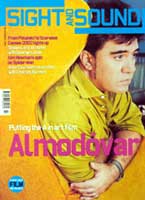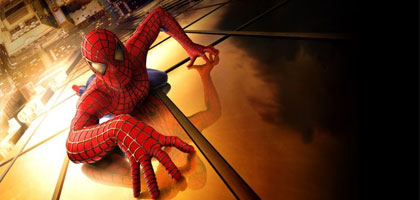
Spin City
Film of the Month: Spider-Man

Spider-Man mixes charm and spectacle. But Aunt May is unmoved. By Kim Newman
It's unfortunate that the teaser trailer for Spider-Man will probably be remembered because it was withdrawn post September 11 rather than for its genuine brilliance. (One hopes American sensibilities will shift sufficiently to allow its inclusion on some future DVD.) Hitting theatres a full year before the film, it began with a bank robbery whose perpetrators escape by helicopter (prompting first-time audiences to wonder which heist movie was being trailed), only to be trapped in a giant web spun between the twin towers of the World Trade Center - an image striking enough to be the cover of a comic book. A glimpse of Spider-Man swinging in the approved fashion among the city's glass canyons was enough to suggest that director Sam Raimi, following the Tales from the Crypt-style horror tone of his Evil Dead films and the rough-draft superheroics of Darkman, might have just the ingenious and daring sensibility required to translate the adventures of Peter Parker, the Amazing (or sometimes Sensational) Spider-Man, to the big screen. As well as displaying a fondness for cameras as acrobatic as any spandex-clad mutant, Raimi demonstrated his grasp of the Marvel style in his reported reaction to the news that Freddie Prinze Jr was interested in the title role: "Freddie Prinze Jr won't even be allowed to buy a ticket to see this film."
Unlike the franchise-building movies of Blade and X-Men, Spider-Man is upfront in crediting Marvel Comics as the source for its characters, proudly declaring that its scenario is based on the work of (writer) Stan Lee and (artist) Steve Ditko. The film spans over ten years of comics continuity, with the first half, the 'origin' story (already the basis of the 1977 pilot for the short-lived television series), drawn primarily from the issue-length story 'Spider-Man' from Amazing Fantasy # 15 (August 1962), though some of the major supporting characters (growling editor Jameson, the anti-Perry White, played to perfection by J.K. Simmons with a Ditko flat-top and Lee wisecracks) made their debut in the early issues of The Amazing Spider-Man (#1 came out in March 1963).
The film-makers working on the Batman, Superman and X-Men movies had the Joker, Luthor and Magneto as ready-made arch-villains, but Raimi and screenwriter David Koepp had to choose from a bewildering range of possible foes. When Tobe Hooper was developing Spider-Man for Cannon in the early 1980s he got as far as casting Bob Hoskins as Dr Octopus, who might once have had a better claim to be Peter Parker's worst enemy. The clever conceit of the original Spider-Man was that he might be stronger than you or me but was still a lightweight in a universe populated by Thor and the Hulk. While Lee and Jack Kirby had the Fantastic Four face threats that escalated from a monarch (Dr Doom) to God (Galactus), Spider-Man worked best when pitted against such small-time misfits as the Vulture, Mysterio and the Lizard, specialists in petty heists rather than in ruling or destroying the planet. The Green Goblin arrived in #14 (July 1964) - and Ditko reportedly walked out after an argument with Lee about who might turn out to be under the mask - but the story arc covered by the film wasn't resolved until #122 (July 1973), by which time (writer) Gerry Conway and (artist) John Romita had elevated the Goblin from comical nuisance to sadistic murderer.
Typical of the way Koepp has had to streamline is the melding of three separate love-interests (Liz Allan, Gwen Stacy, Mary Jane) into a single character. Purists may regret the transformation of a defining moment in comics, the death of Gwen Stacy, into a standard bit of derring-do as the film's Peter saves his girl by pulling off the feat his comics counterpart couldn't (in a rare acknowledgement of the laws of physics, Spider-Man caught the girl as she was falling from the Brooklyn Bridge but inertia snapped her neck anyway).
It was a stroke of genius in 1962 to develop a superhero who was a 'friendly neighbourhood' Spider-Man, someone who discovered that the proportionate strength of a spider didn't help him to get a date, do his homework on time or appease weak-hearted old Aunt May. The best elements of Raimi's film restate this story with both charm and cynicism: Tobey Maguire's doofus Parker, mooning over the unattainable girl next door and bickering with his well-meaning guardians, is a winning character. Raimi plays clever games with the icon. After he's gained his powers, we see Parker sketching costume ideas, developing the now famous Spider-Man look. The big build-up to his arrival in the wrestling ring pays off when Parker shows up anti-climactically in a red balaclava and a baggy tracksuit sporting a badly screened spider emblem. Only when he takes to the skies does he get the cool threads, and the CGI team does a wonderful job of recreating those Ditko or Romita frames of Spider-Man perched atop landmarks or swinging between skyscrapers, even coming up with ways to make sense of the still images in terms of motion.
The other Marvel innovation was to have its heroes live in the real world rather than in Metropolis or Gotham City, and there's a genuine feel here for the modest working-class neighbourhood where Peter grows up as well as for the dazzle of Manhattan where he moves after graduation. Jameson's Daily Bugle is published out of the Flatiron Building, Spider-Man perches on one of the Chrysler Building's gargoyles and the finale takes place where Peter's child and adult identities intersect: at the 59th Street Bridge. The proliferation of muggers and heist-men rousted by Spider-Man suggests a pre-Giuliani, pre-zero tolerance city. Elsewhere, though, the pruning of a few dated elements from the origin (this spider is genetically engineered rather than radioactive; the web-shooters are organic rather than gadgets) looses the story from the specifics of the early 1960s without too trendily embracing the present day. The World Trade Center isn't seen but neither is its former site; a sense of post-9/11 New York resilience is suggested by a glimpse of the stars and stripes in the final shot.
Like too many first films in superhero franchises, Spider-Man doesn't quite hold together: the story hits all the emotional beats, but the action too often devolves into the cartoonish contortions of a pair of high-flying opponents, with plot leaps patched over by speech-balloon-style exposition. As with his new-minted hero Darkman, Raimi seems unsure of his central character's powers, and the relationship between hero and villain lacks the masochistic heat that sparks great superhero-supervillain enmities. The obligatory 'temptation' scene, as the Goblin appeals to Spider-Man to join him and take over the city, is played flatly through masks. But Spider-Man is full of deftly handled small moments and characters. There's Kirsten Dunst's unassuming niceness as Mary Jane, and a terrific first kiss as she peels the mask from Spider-Man's mouth while he hangs upside down. Willem Dafoe patents a ghastly cackle, though he makes Osborn a tormented Jekyll- and-Hyde fiend rather than the comic's bullying psycho, and Cliff Robertson as Ben Parker displays a blue-collar dignity in a role that owes a lot to Glenn Ford's Pa Kent. A Thanksgiving dinner in Peter and Harry's New York student apartment promises solidarity among an extended family of lonely people but falls apart when the Goblin personality overwhelms Harry's Dad. And finally there's Rosemary Harris' Aunt May, gently reminding Peter, "You're not Superman."
